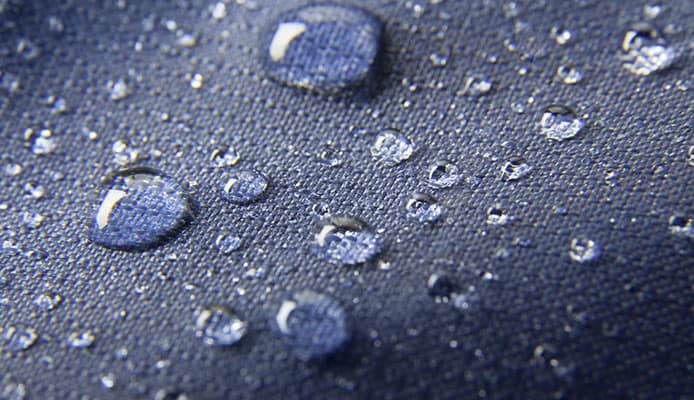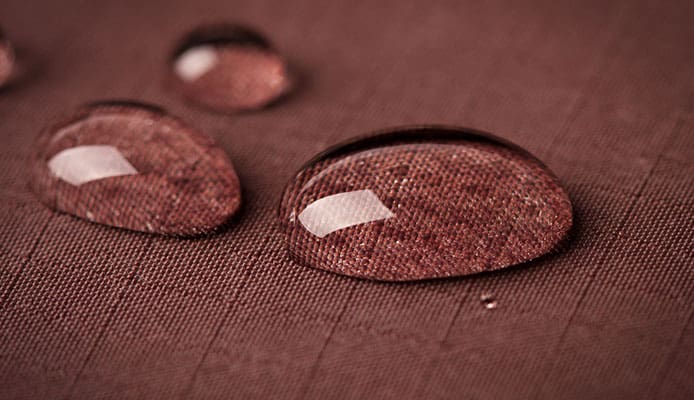
For many people, there really isn’t much of a difference between water-resistant vs. waterproof which is why they end up using these terms interchangeably or incorrectly. A bigger problem though is that many brands misrepresent their product’s ability to resist water due to incorrect labeling. Hopefully, this article can help iron out some of those issues. First off though, many different terms are used to describe an item’s ability to resist water, but for the sake of this article, let’s focus on the three most commonly used terms: water-resistant, water-repellent, and waterproof.
What Does Water-Resistant Mean?
Water-resistant refers to an item’s ability to resist the penetration of water to some degree. This means that water won’t be able to get inside the item easily, but there is still a chance that water will get through at some point. Of the three terms discussed here, water-resistant offers the lowest level of water protection.
Take for example water-resistant fabrics. Many outdoor gears, from jackets to camping tents, are often labeled as water-resistant. These items can protect you from light rains and minimal moisture, but they won’t be able to do so in cases of heavy rains. Water will certainly seep through the fabric and leave you cold and wet in such circumstances.
The same holds for water-resistant watches. You can wash your hands without the need to remove your watch, but you certainly wouldn’t want to go swimming with it.
The water-resistant property of an item is generally attributed to the material used to make it. Going back to fabrics, the density of the fabric is what makes it resist water. The most common fabrics that can be called water-resistant are nylon and polyester, and their water-resistance can be credited to how tightly they are woven. Think of it this way, the tighter the weave, the fewer holes or openings there are for water to enter. Water-resistant fabrics aren’t going to keep you from getting wet forever, but because they are so dense, it takes a lot longer for the water to seep in.
What Does Water-repellent Mean?
Water-repellent is a step up from water-resistant, though it doesn’t necessarily mean that it makes the item impervious to water since it is still susceptible to water entry and consequently water damage.
The difference between water-resistant and water-repellent is pretty straight-forward. As mentioned earlier, water-resistant items owe their ability to resist water penetration to the material used. On the other hand, water-repellent items can resist water because of a coating or treatment applied to them. These coatings can be applied inside or outside the item. Sometimes, the coating is applied on both sides to enhance its chances of standing up to water penetration.
What Does Waterproof Mean?
When an item is labeled as waterproof, it means that the item is impervious to water but not infinitely. That said, even waterproof items can get wet if it’s subjected to extreme water exposure. Sad but true. Even diving watches labeled as waterproof, which many people think is invulnerable to water given their name and purpose, are prone to water penetration at some point.
What’s the Ingress Protection Scale?
So if nothing is truly ever waterproof, what’s with all the different terms then?
To make things simpler, it would be better to think of an item’s ability to resist water as a sliding scale instead of a set defining line. There is a system called the Ingress Protection rating scale which is used to describe an item’s ability to fend off water. This rating scale applies to most tech items like smartphones, digital cameras, smartwatches, coolers, and various other pieces of camping and high-tech gear.
The Ingress Protection rating scale is rather simple: the higher the number, the higher the water-resisting property. For instance, a rating of IPX-0 means that the item has absolutely no protection against water whatsoever, whereas a rating of IPX-8 means that the object is suitable for continuous immersion in water at a depth of more than 1 meter.
That said, you should be able to tell exactly how waterproof something is so long as you know its rating. You can check an item’s Ingress Protection rating by looking at its packaging or in its tech specs on the manufacturer’s website.
You might also like: Dry Bags
What about Waterproof Tents?

What’s most important to keep in mind about the Ingress Protection rating scale is that it does not apply to fabrics, like those used in jackets, camping tents, or hiking packs. So how then do you know when the camping tent you intend to buy is capable of keeping you and your family or friends dry in case of a sudden downpour during your kayak camping trip?
Unfortunately, there is no exact way of knowing. You can check the label and search for the term ‘waterproof’ but that alone is not enough to ensure that water won’t be able to seep through it. You can try the following tips though.
Buy from reputable brands. Big brands are big for a reason, one of which is their credibility. That said, when a brand says that their tents are waterproof, then there is a high chance that it probably is. After all, big brands won’t become big if they’ve been lying about their products and misleading customers.
Avoid cheap imitation. One sure way of being scammed is by being an imitation or cheap knock-off camping tent. Needless to say, these products won’t be able to fend off water no matter how waterproof they claim to be.
Check the seams. Each stitch and seam in the fabric is another hole where water can pass through. That said, you’ll want to look for a camping tent that is well-constructed and has tight and uniform seams and stitches. Also, check that the seams do not have a lot of stray material stitched or loose ends which could be a sign that quality is not the best.
Waterproofing of seams is achieved via a coating or treatment as is the case with water-repellent fabrics. Still, you need to keep in mind that the coating or treatment will wear off after a time. Some camping tents also utilize other methods to further enhance their waterproof qualities like overlapping the material and reducing the amount of stitching that goes through the outer tent fabric.
Check the zippers. Tent entryways are always a potential place for rain to come in. Thus, you’ll want to make sure the zips on the tent are protected from the rain. High-quality waterproof tents usually have fabric and sometimes even a plastic cover to keep water away from the zip. If you just see a normal zip on the side of the tent without any fabric or plastic cover, that that’s likely to be a source for water entry.
Check the hydrostatic head. Hydrostatic head is the measure of how water resistant your tent material is. It measures how tall a column of water the fabric can hold before water starts to seep through the weave. A more suitable definition though would be that it is the measure of water pressure equivalent to the height of a column of water. For instance, a hydrostatic head of 3000mm means that a tent fabric could hold a column of water that is 3000mm tall. The higher the hydrostatic head value, the more water-resistant a fabric is, and the more water pressure it can withstand before it leaks.
Read customer reviews. Perhaps the best way to know just how waterproof a particular camping tent is would be to read the reviews and comments made by actual people who have used the tent. You can go to your favorite search engine and simply type in the name of the tent you’re eyeing and attach the keyword ‘review’ or ‘forums’. Just be careful concerning these reviews since some of them may be hokey or paid reviews.
If you still can’t find a waterproof or water-resistant camping tent that suits your needs and wants despite all your efforts, then don’t worry because you can actually waterproof your tent which you have now. Doing so will require some work (especially with cleaning and preparing your tent’s surface) as well as some supplies like water or liquid sealant. Still, it’s worth all the trouble if it means that you can rest peacefully inside your tent without having to worry about water dripping onto your face while you’re sleeping.
Globo Surf Overview
Unfortunately, it’s not always easy to tell whether something is waterproof or just water-resistant at a glance and it’s made even harder by a lack of standardized testing practices. Most brands have their own facilities and methods in coming up with their own determining factors for things like water resistance vs. waterproof and so on. Still, the information above should be able to help you navigate the gear landscape and make sure that you’re getting the right kind of water protection that you want from your gear.
More Watergear Water Protection Reviews:
- Waterproof Duct Tapes
- Waterproof Wallets
- Waterproof Phone Cases
- Waterproofing Sprays
- Travel Umbrellas
- Underwater Camera Housings
- Waterproof Cast Covers
- Waterproof Duffel Bags
Source

